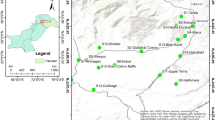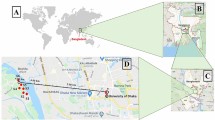Abstract
Soil cadmium (Cd) contamination resulted from mining and smelting is a major environmental concern, and health risk associated with Cd exposure to multi-media through muti-pathway is increasing. Cd concentrations in soils, vegetables and paddy rice were investigated, and potential non-carcinogenic and carcinogenic health risks exposure to Cd were estimated at six villages around the Dabaoshan Mine, South China. A total of 87 soil samples were found to exceed the China’s maximum permission level (MPL) for Cd, while the highest value of 4.42 mg/kg was found near irrigation ditch associated with Hengshi River in Xinyi (XY) Village. Cd contents in vegetables and rice exceeded the maximum permissible concentration by more than five times in every village. Cadmium accumulation in plants is in the order of celery > lactuca sativa L > Chinese cabbage > Romaine lettuce > asparagus lettuce > mustard > cabbage mustard > cabbage. The mean hazard quotient (HQ) of all villages is in the range of [5.29, 25.75], and the mean values of cancer risk for investigated areas are more than 10 times greater than the USEPA (2009) threshold limit value of 10−4. Moreover, human non-carcinogenic and carcinogenic risks are mainly attributable to paddy rice intake, followed by vegetables intake, soil ingestion, inhalation, and dermal contact. The results indicate that Cd has a huge potential risk on human health for the local residents.
Similar content being viewed by others
References
World Health Organization (WHO). Cadmium [R]. Geneva: Environmental Health Criteria, vol. 134. WHO, 1992.
ADRIANO C. Trace Elements in terrestrial environments: Biogeochemistry, Bioavailability, and risks of metals [M]. 2nd edition. Berlin: Springer, 2001: 263–314.
US Department of Health and Human Services. Cadmium and Cadmium Compounds CAS No. 7440-43-9 (Cadmium) [R]. Washington, DC Report on Carcinogens, Twelfth Edition, 2011.
JÄRUP L, AKESSON A. Current status of cadmium as an environmental health problem [J]. Toxicology and Applied Pharmacology, 2009, 238: 201–208.
United States Environmental Protection Agency (USEPA). Risk-based Concentration Table [R]. Philadelphia PA: United States Environmental Protection Agency, Washington Agency, Washington DC, 2000.
Food Safety Commission. Assessment report on contaminants: ensuring safe level of cadmium intake from food [R]. Tokyo, Japan: Food Safety Commission, 2008.
European Food Safety Authority. Cadmium in food: Scientific opinion of the panel on contaminants in the food chain [J]. The EFSA Journal, 2009, 980: 1–139.
Joint Food and Agriculture Organization/World Health Organization Expert Committee on Food Additives. Joint FAO/WHO Expert Committee on Food Additives seventy-third meeting, Summary and conclusion [R]. Geneva: FAO/WHO, 2010: 1–17.
National Bureau of Statistics of China. Amount of Pollutants Discharged in the Industrial Waste Water [EB/OL] [2011-11-26]. http://www.stats.gov.cn/tjsj/qtsj/hjtjzl/hjtjsj2010/t2011122640278820.htm. (in Chinese)
WANG Zhen-xing, CHEN Jian-qun, CHAI Li-yuan, YANG Zhi-hui, HUANG Shun-hong, ZHENG Yu. Environmental impact and site-specific human health risks of chromium in the vicinity of a ferro-alloy manufactory, China [J]. Journal of Hazardous Materials, 2011, 190: 980–985.
LI Fei, HUANG Jin-hui, ZENG Guang-ming, YUAN Xing-zhong, LIANG Jie, WANG Xiao-yu. Multimedia health risk assessment: A case study of scenario-uncertainty [J]. Journal of Central South University, 2012, 19: 2901–2909.
ZHAI Li-mei, LIAO Xiao-yong, CHEN Tong-bin, YAN Xiu-lan, XIE Hua, WU Bin, WANG Li-xia. Regional assessment of cadmium pollution in agricultural lands and the potential health risk related to intensive mining activities: A case study in Chenzhou City, China [J]. Journal of Environmental Sciences, 2008, 20: 696–703.
ZHAO Hua-rong, XIA Bei-cheng, FAN Chen, ZHAO Peng, SHEN Shi-li. Human health risk from soil heavy metal contamination under different land uses near Dabaoshan Mine, Southern China [J]. Science of the Total Environment, 2012, 417–418: 45–54.
ZHUANG Ping, MCBRIDE B, XIA Han-ping, LI Ning-yu, LI Zhian. Health risk from heavy metals via consumption of food crops in the vicinity of Dabaoshan mine, South China [J]. Science of the Total Environment, 2009, 407(5): 1551–1561.
USEPA. Exposure factors handbook: 2009 update. EPA/600/ R-09/052A [S].
The Bulletin of National Economic and Social Development Statistics for Shaoguan City (2006–2011) [EB/OL] [2012-03-26]. http://www.shaoguan.gov.cn/website/portal/html/002002/2012/ 1003670.html. (in Chinese)
JAN F A, ISHAQ M, KHAN S, IHSANULLAH I, AHMAD I, SHAKIRULLAH M. A comparative study of human health risks via consumption of food crops grown on wastewater irrigated soil (Peshawar) and relatively clean water irrigated soil (lower Dir) [J]. Journal of Hazardous Materials, 2010, 179: 612–621.
Statistics Bureau of Guangdong Province, Survey Office of the National Bureau of Statistics in Guangdong. Guangdong statistical yearbook 2011 [M]. Beijing: China Statistics Press, 2012: 244. (in Chinese)
Ministry of Environmental Protection. Guidelines for Risk Assessment of Contaminated Sites [EB/OL] [2014-02-26]. http://kjs.mep.gov.cn/hjbhbz/bzwb/trhj/trjcgfffbz/201402/t20140226 268358.htm.
State of Environmental Protection Agency (SEPA). Environmental quality standard for soils (GB 15618-1995) [S]. (in Chinese)
State of Environmental Protection Agency (SEPA). Chinese soil background values [S]. Beijing: China Environmental Science Press, 1990. (in Chinese)
GB 2762-2005. Ministry of Health of China (MHC). China’s maximum levels of contaminants in foods. [S]. (in Chinese)
World Health Organization (WHO). Codex Maximum Level for Cadmium in Cereals. Pulses and Legumes CAC/GL 39 [S].
SUN Hong-fei, LI Yong-hua, JI Yan-fang, YANG Lin-sheng, WANG Wu-yi, LI Hai-rong. Environmental contamination and health hazard of lead and cadmium around Chatian mercury mining deposit in western Hunan Province, China [J]. Transactions of Nonferrous Metals Society of China, 2010, 20: 308–314.
YANG Yong, ZHANG Fu-suo, LI Hua-fen, JIANG Rong-feng. Accumulation of cadmium in the edible parts of six vegetable species grown in Cd-contaminated soils [J]. Journal of Environmental Management, 2009, 90: 1117–1122.
YANG Yi-ming, NAN Zhong-ren, ZHAO Zhuan-jun, WANG Zhao-wei, WANG Sheng-li, WANG Xia, JIN Wang-qiang, ZHAO Cui-cui. Bioaccumulation and translocation of cadmium in cole (Brassica campestris L.) and celery (Apium graveolens) grown in the polluted oasis soil, Northwest of China [J]. Journal of Environmental Sciences, 2011, 23(8): 1368–1374.
WANG Mao, SONG Hong, CHEN Wei-qing, LU Ci-yong, HU Qian-shen, REN Ze-fang, YANG Yan, XU Yan-jun, ZHONG Ai-ming, LING Wen-hua. Cancer mortality in a Chinese population surrounding a multi-metal sulphide mine in Guangdong province: An ecologic study [J]. BMC Public Health, 2011, 11: 1–15.
ENGSTRÖM A, MICHAËLSSON K, VAHTER M, JULIN B, WOLK A, ÅKESSON A. Associations between dietary cadmium exposure and bone mineral density and risk of osteoporosis and fractures among women [J]. Bone, 2012, 50: 1372–1378.
KAWADA T, SUZUKI S. A review on the cadmium content of rice, daily cadmium intake, and accumulation in the kidneys [J]. Journal of Occupational Health, 1998, 40(4): 264–269.
INABA T, KOBAYASHI E, SUWAZONO Y, UETANI M, OISHI M, NAKAGAWA H, NOGAWA K. Estimation of cumulative cadmium intake causing Itai-itai disease [J]. Toxicology Letters, 2005, 159(2): 192–201.
Author information
Authors and Affiliations
Corresponding author
Additional information
Foundation item: Project(51204074) supported by the National Natural Science Foundation of China; Projects(2010009017, 201209048, ZX021-201106-031) supported by the National Environmental Protection Public Welfare Industry Targeted Research Fund, China
Rights and permissions
About this article
Cite this article
Wang, Zx., Hu, Xb., Xu, Zc. et al. Cadmium in agricultural soils, vegetables and rice and potential health risk in vicinity of Dabaoshan Mine in Shaoguan, China. J. Cent. South Univ. 21, 2004–2010 (2014). https://doi.org/10.1007/s11771-014-2149-3
Received:
Accepted:
Published:
Issue Date:
DOI: https://doi.org/10.1007/s11771-014-2149-3




